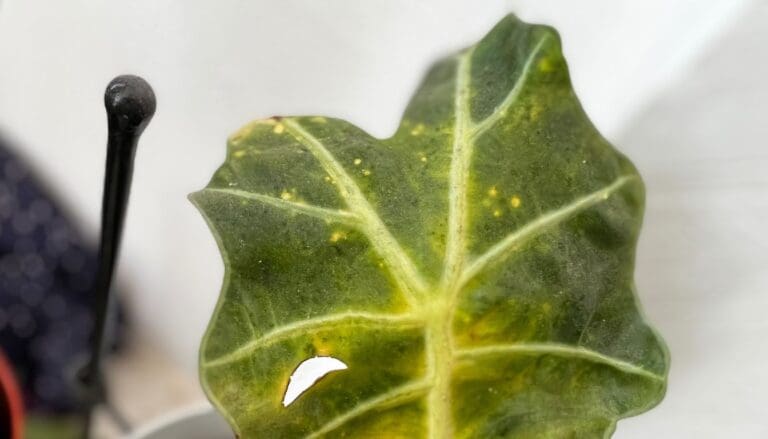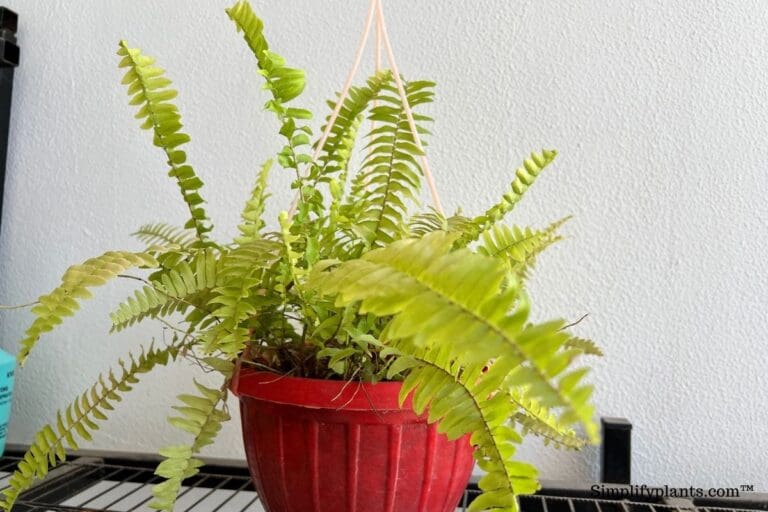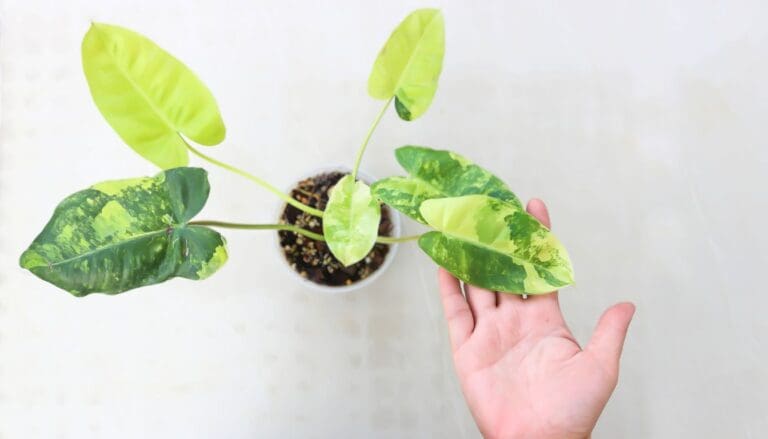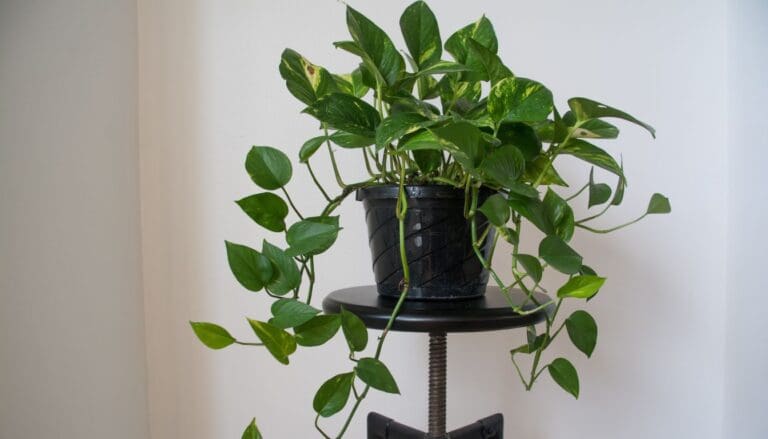Soil For Rubber Plant? (What To Use+Ideal DIY Soil Mix)
Rubber plants can survive in various potting soil mixes, but you must choose the suitable soil mix for their best performance. It is exciting to grow a Rubber plant, but the best soil type for them can be tricky.
Rubber plants need moist soil with good drainage. You can create your own mix with various ingredients or opt for store-bought soil. For proper drainage, the mix must have perlite, pumice, or cactus soil. The pH should be 5.5 to 7.
Choosing the suitable potting soil for the well-being of the Rubber plant is tricky. But don’t worry. This guide explores the ideal soil requirements, factors to consider, soil recipes and commercial blends, and tips to maintain healthy soil.

Please note: Simplify Plants is reader-supported. Some links in the post are affiliate links and I get a commission from purchases made through links in the post.
Rubber plant soil requirements
I am a big fan of Rubber plants (Ficus Elastica).
I love how my plants have grown since I bought them at home.
Whenever I share pictures, I get questions about how I have maintained the plant and what basic requirements they need.
Rubber plants are low-maintenance plants.
They can survive various conditions, but you should provide the exact requirements like their native land for their best performance.
Today, I will talk about the soil requirements.
While growing Rubber plants as houseplants, you must mimic the plant’s natural habitat to make it realize it’s in its native land.
For Rubber plants, the ideal soil mix includes a balance of sand, silt, and clay.
The combination will encourage good drainage and retain enough moisture for hydration.
Factors to consider while choosing the suitable soil for the Rubber plants
When selecting suitable soil for your Rubber plants, you must consider a few factors and ensure that you can give your plants an excellent growing medium.
Let me take you through these factors while choosing the suitable potting soil for Ficus Elastica:
Soil drainage and moisture management
Rubber plants prefer well-drained soil and are not waterlogged.
A good way to maintain such soil is by using well-drained soil and watering it only when the top few inches have dried.
To maintain the correct drainage, look for soil mixes that contain perlite or sand.
If you are making your own mixes, add these to the potting mix.
These ingredients can prevent water from pooling around the roots.
You may also add some organic matter to improve the soil structure and provide essential nutrients to the plant.
Moisture holding capacity
Aside from good drainage, you must also ensure proper moisture retention.
Rubber plants prefer staying consistently moist throughout.
It will start suffering if the soil becomes too dry.
To ensure proper retention, check for soil mixes that contain organic matter like peat moss or coco coir.
These ingredients can retain moisture without making the soil saturated.
Soil pH level
Rubber plants prefer slightly acidic to neutral soil.
The pH level should be around 5.5 to 7.
You need to check the pH level before you buy the soil or make the mix at home.
The commercial potting mixes have neutral potting mixes.
But if you prefer slightly acidic soil, add some African violet mix or composted pine bark.
Soil aeration
The soil has to be well-aerated so that the roots get enough oxygen to breathe.
Proper aeration prevents root suffocation and enhances root health and structure.
It will also prevent waterlogging, prevent root rot, and support the plant’s overall growth and development.
To ensure proper aeration, include ingredients like perlite, pumice, or vermiculite in the soil mix.
Nutrient balance

Rubber plants need sufficient nutrients for good growth and development.
Rubber plants require three main nutrients: nitrogen, phosphorus, and potassium, along with other micronutrients like iron, magnesium, calcium, manganese, and zinc.
You should make a soil that can provide these nutrients to the plant.
Choose a potting mix containing slow-release fertilizers.
These extra additions can give your Rubber plants a steady supply of nutrients over time and encourage lush green leaves and healthy growth.
Materials to be used in the Rubber plant potting soil
Whether you are buying commercial potting mixes or making your own homemade recipes, you should always ensure that the following ingredients are present in the soil:
- Coco coir – Organic matter made from coconut husks. It improves drainage and aeration while holding moisture and nutrients.
- Perlite – Expanded rocks resembling small bits of styrofoam. Improves aeration and drainage.
- Vermiculite – Expanded minerals that retain moisture and improve aeration.
- Pumice – Volcanic rocks with small pores. It can encourage drainage and aeration.
- Sphagnum Peat moss – Organic matter made under anaerobic conditions that can retain moisture and nutrients.
- Coarse sand – Improves drainage and aeration.
- Compost – Decomposed organic matter, especially thoroughly aged compost.
- Pine bark fines – Small pine bark pieces that can improve drainage and aeration
- Rocks – Improves drainage.
- Soil activators – Boost the soil with beneficial microbes to let the plant access nutrients and keep diseases away.
To enhance drainage, retention, and nutrient content, it’s essential to include most of these ingredients in the soil.
Signs of wrong soil and remedies in the Rubber plant
Selecting a suitable soil type is crucial.
But how will you understand whether your soil mix is correct?
Don’t worry.
The plant gets stressed when grown in the wrong soil, and it displays some signs through the leaves.
If you observe the plant daily, you will be able to notice this, understand the issue, and take immediate action to remedy it.
A wrong potting mix has poor drainage or retention qualities. It can also have wrong pH levels, creating an imbalance in the nutrient ratio.
Excessive moisture levels

When the potting mix is heavy and doesn’t drain well, it holds moisture for a long time. Over time, you will notice the following signs:
- Yellow or brown leaves
- Wet soil for a long time
- Leaves developing brown or yellow spots
- Drooping leaves and defoliation
These are the signs of overwatering and root rot.
If your watering is correct, and the pot has drainage holes, the soil is the problem.
Does your soil have drainage materials, like perlite or sand?
If not, add them immediately to address the issue and see if the problem reverses.
If this doesn’t work, repot your plant with a new, suitable potting mix.
Make sure the soil is well-drained.
Your plant will recover after a few weeks.
Remove the entirely discolored leaves to encourage new growth.
Dry soil and lack of nutrition

Using too much sand or planting in a fresh potting mix will dry much before the plant can absorb the moisture and nutrients.
It further shows signs of underwatering and lack of nutrients.
Common signs are:
- Yellow leaves
- Crispy and dry leaves
- Dry soil
- Stunted growth
To address the issue, add materials that can increase retention qualities.
Peat moss and coco coir can hold both moisture and nutrients.
Also, increase watering to keep the soil consistently moist.
If it still doesn’t work, repot your plant with new soil suitable for Rubber plants.
Soil Mix Ideal for Rubber plants
Now that you know the soil requirements, signs of the wrong potting mix, and how to adjust them, let’s learn about some ideal soil types for Rubber plants to prevent the above issues.
Several types of soil mixes work great for the Rubber plants.
Whenever people ask me about the ideal soil types for Ficus Elastica, I suggest the following types:
Commercial Potting mix
In this mix, you get various ingredients that can help in drainage, nutrition, retention, and proper pH levels.
The potting mix for the Rubber plants typically contains a blend of peat moss, perlite, vermiculite, and organic matter.
This potting mix will ensure air circulation around the roots and prevent overwatering and root rot.
At the same time, it will also help in retaining sufficient moisture to maintain hydration.
Cactus mix

If you don’t want to spend time and effort making any blends, you can use Cactus mix for your Rubber plants.
These soil types have excellent drainage and, therefore, can be ideal for these plants.
The mix contains sand, perlite, and soil additives like peat moss or coco coir to retain moisture.
Cactus mix is perfect for people who overwater the plants or live in humid regions.
Moisture becomes an issue in such cases, and Cactus mix can help you overcome it.
African violet mix
Another soil type is the African violet potting mix.
These types of soil are prepared to provide excellent drainage and retention equally.
The African violet soil mix contains a blend of peat moss, perlite, vermiculite, and other organic materials.
Rubber plants prefer slightly acidic to neutral soil with a pH of 5.5 to 7.
African violet potting mix can be a perfect soil for them as the soil is more acidic.
Loam-based soil mix
Loam-based potting mix is not only ideal for Rubber plants but many other houseplants too.
Moreover, these soil types are ideal for plants needing slightly richer soil. So, Rubber plants will benefit from them.
The soil mix usually contains a mixture of sand, silt, and clay in a balanced ratio, giving sound drainage while retaining moisture and nutrients.
The loam-based mixes also contain organic matter like compost or aged manure to improve the soil structure and fertility.
Soil mix recipes for Rubber plants
If you are struggling to get a premade soil mix containing a perfect ingredient ratio, make your own soil mix for the Rubber plants.
Here, you can add ingredient amounts as per your choice and make the soil mixture ratio perfect for the Rubber plants.
Below are some recipes I have shared.
I have used most of them, and a few I got to know while researching recently, and going to use them during the next repotting session.
Even after years of growing Rubber plants, I constantly research to give my plant the best.

Let’s have a quick look at the soil recipes:
Recipe 1
- One part peat moss or potting soil
- One part pine bark
- One part coarse sand or perlite
Recipe 2
- 2 parts Miracle-Gro Indoor Potting Mix
- One part of perlite, pumice, or coarse sand
Recipe 3
- One part cactus mix
- One part compost
- One part peat moss or coco peat
Recipe 4
- 3 parts Miracle-Gro potting mix
- One part perlite
- One part of orchid bark
Recipe 5
- 20% vermicompost or compost
- 30% perlite or sand
- 30% coarse Orchid bark
- 20% peat or coconut fiber
Recommended store-bought potting mixes

Making your own soil mixes can be messy, and it takes a lot of time and effort.
Many of my readers and friends don’t have time to create their own soil recipes.
Don’t worry, I have a solution for this.
If you don’t have time to make soil recipes or want to avoid the mess, buy commercial potting mixes designed for the Rubber plants.
Any good-quality potting soil would work fine for them.
However, sometimes, you may still need to add 1-2 ingredients to improve drainage, retention, or fertility.
Whenever I don’t get time to make soil recipes, I search for a perfect blend for my precious Ficus Elastica.
Here’s a list of some commercial soil mixes for the Rubber plants I have researched and used:
- SUN GRO Horticulture All Organic Potting Soil
- Miracle-Gro Indoor Potting Mix
- Miracle-Gro Tropical Potting Mix
- Fiddle Leaf Fig House Plant Soil Premium All-Purpose Blend
- Jessi Mae – Tropical Plant Potting Soil
Each of these options works well for Rubber plants, but my favorite is the first one.
It can be tricky to choose the right soil mix for the Rubber plant.
You can also choose from the other ones if you like.
Look at the ingredients mentioned in the potting soil.
The soil must have ingredients mentioned in “Materials to be used in the Rubber Plants.”
Encouraging healthy Rubber plant soil

Once you have learned about the soil requirements and selected an ideal soil type for your Ficus Elastica, you will want to keep the soil healthy in the long run.
Here are some ways to keep the soil in good condition:
- One of the primary ways to keep the soil healthy is to maintain the watering frequency. Overwatering leads to root rot, and underwatering hardens the soil. Unfortunately, you have to change the soil. Always water the plant whenever the top few inches have dried.
- The next thing to maintain is the fertilization schedule. Fertilizing too much can contaminate the soil and reduce its quality. Always fertilize the Rubber plants every 2-4 weeks in the growing season and avoid it in winter. Flush the soil monthly to remove the salt buildup from the fertilizers.
- Let the Rubber plants have bright indirect sunlight. Lowlights can keep the soil wet for too long, and direct sunlight can dry out the soil and harden it. It can reduce the soil’s quality. So, maintain bright filtered sunlight for the Rubber plants.
- Keep your plant away from heating vents or air conditioners. They not only affect the plant but also the soil by drying them out faster. Maintain at least 10 feet distance.
Rejuvenating the soil by repotting the Rubber plants

No matter how healthy you keep the soil, you must rejuvenate the soil by repotting the Rubber plants once a year during the spring and summer.
Over time, the root ball grows big and spreads, and the soil gets depleted and loses its quality.
Repotting gives room to the root ball, and new soil will keep the plant healthy.
While repotting, choose a pot size 1-2 inches bigger than the old one.
Make sure the pot has drainage holes.
As for the soil, it is better to stick to the same potting mixes for the plant.
I’ve grown many Rubber plants through propagation, and I enjoy experimenting with various potting mixes.
But I don’t change the potting mix for one specific plant.
For instance, when one Rubber plant grows with soil recipe 1, I use the same mix every time while repotting.
For another plant, I use a commercial potting mix, and it’s the same throughout.
I use a different soil mix or recipe only when I grow a new Rubber plant.
These tips will not only keep your plant healthy and thriving but also encourage pest and disease control.
Final thoughts
Choosing the ideal soil type for the Rubber plants is vital for their overall health and development. Consider the drainage, retention, nutrient content, and pH levels before you plant the Rubber plants. Ensure the plant stays in the best possible growing conditions and keeps thriving.
Common signs of wrong soil include yellowing, browning, defoliation, and stunted growth. To remedy the condition, add ingredients to improve drainage and retention qualities like perlite, coarse sand, organic matter, peat moss, or coco coir. I have shared several options for choosing suitable soil types, some soil recipes, and commercial potting mixes.
You can use any one of them without hesitation. To maintain healthy soil, regularly monitor moisture levels, water the plant when the top few inches are dry, and fertilize every 2-4 weeks or monthly during spring and summer.
What is the best pot for Rubber plants?
Terra cotta is excellent as it is porous and wicks away moisture faster, preventing overwatering and root rot. If you forget to water frequently, go for plastic pots. The best is to use self-watering pots.
When and how often should I repot my Rubber plants?
Annual repotting of the Rubber plants should be done in spring or summer. Repotting gives space to the root ball, rejuvenates the soil, and ensures good growth. Doing it in the growing months promotes fast recovery. Keep caring to help them heal faster.
Reference: Ficus Elastica Wikipedia
Recommended Garden Supplies
| Product Image | Our Recommended Gardening Supplies | Check Offers! |
|---|---|---|
Top Top
Top
Top
Top
Top
Top
Top
Top | rePotme Houseplant and Tropical Classic Potting Soil Mix | Check Offer On Amazon |
 Top
Top
Top
Top
Top
Top
Top
Top | Espoma Organic Indoor Plant Food | Check Offer On Amazon |
 Top
Top
Top
Top
Top
Top
Top
Top | GooingTop LED Grow Light 6000K Full Spectrum Clip Plant Growing Lamp | Check Offer On Amazon |
 Top
Top
Top
Top
Top
Top
Top
Top | Soil Moisture Meter | Check Offer On Amazon |
 Top
Top
Top
Top
Top
Top
Top
Top | Govee Hygrometer Thermometer, Bluetooth Enabled! | Check Offer On Amazon |
 Top
Top | LEVOIT Humidifiers for Large Room(Best For Plants) | Check Offer On Amazon |
 Top
Top
Top
Top
Top
Top
Top
Top | Upgraded DIY Automatic Drip Irrigation Kit, 15 Potted Houseplants Support | Check Offer On Amazon |
 Top
Top
Top
Top
Top
Top
Top
Top | Stainless Steel Heavy Duty Gardening Tool Set | Check Offer On Amazon |
 Top
Top
Top
Top
Top
Top
Top
Top | Bonide Insecticidal Soap | Check Offer On Amazon |
 Top
Top
Top
Top
Top
Top
Top
Top | Bonide 32 oz Spray Neem Oil for Organic Gardening | Check Offer On Amazon |
 Top
Top
Top
Top
Top
Top
Top
Top | Garden Safe Fungicide | Check Offer On Amazon |






